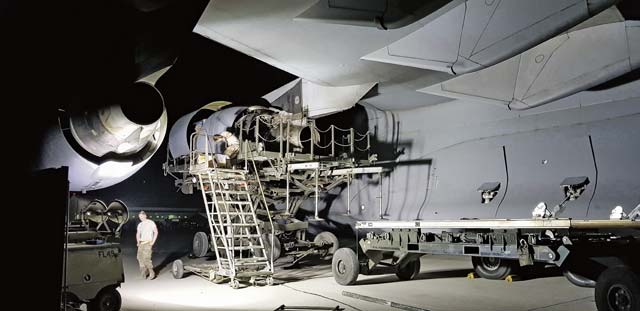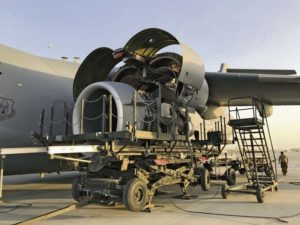
Joint Base McGuire-Dix-Lakehurst, New Jersey — A team of en-route maintenance Airmen recently converged from multiple locations to respond as part of a Maintenance Recovery Team, returning a C-17 Globemaster III aircraft back to the mobility fleet from a forward deployed location in Southwest Asia.
Maintenance professionals identified repairs to the aircraft that required additional parts and maintenance personnel beyond what was available at the forward deployed location.
“This was a unique event where multiple squadrons worked together to repair an aircraft in an expeditionary environment, showing the true capability of the en- route system — to rapidly respond, overcome challenging maintenance issues and environments, and return an aircraft to the fight,” said U.S. Air Force Capt. Alexandra Gegen, 8th Expeditionary Air Mobility Squadron’s assistant director of operations.
Within 24 hours, the 521st Air Mobility Operations Wing, headquartered at Ramstein Air Base, rapidly channeled and assembled the necessary aircraft parts and the MRT personnel comprised of five aircraft maintainers from the 721st Aircraft Maintenance Squadron at Ramstein, three maintainers from the 8th EAMS’ main deployment location, and an additional three maintainers from an 8th EAMS’ detachment location.
Along with the C-17’s dedicated flying crew chief, U.S. Air Force Staff Sgt. Alan Morris, from the 305th AMS at Joint Base-McGuire-Dix-Lakehurst, N.J., the team worked shoulder to shoulder, replacing one of the aircraft’s engines and an integrated flight control module.
 “I was extremely impressed at how well this engine change went, especially considering we had Airmen from four different bases who had never worked together before,” said U.S. Air Force Master Sgt. Reliot Rodriguez, 8th EAMS production superintendent. “It is a true testament to the outstanding caliber of maintainers we have across the Air Force.”
“I was extremely impressed at how well this engine change went, especially considering we had Airmen from four different bases who had never worked together before,” said U.S. Air Force Master Sgt. Reliot Rodriguez, 8th EAMS production superintendent. “It is a true testament to the outstanding caliber of maintainers we have across the Air Force.”
U.S. Air Force Capt. Ryan Huff, 721st AMXS aircraft maintenance unit officer in charge, explained further.
“Bringing together assets from three locations, from two continents, across two wings in different MAJCOMs to fix a single asset is but a taste of the capabilities and quality of Airmen in the en-route system,” Huff said.
Air Mobility Command’s global en-route system is the foundation for the rapid, global movement of aircraft, cargo and personnel. Similar to the presence of commercial cargo terminals at major international airports — which unite surface and air transportation networks to move packages and cargo — Air Mobility Command has a permanent global en-route presence at more than 30 key locations around the world, large and small, from Europe to the Middle East, and all throughout the Pacific. Mobility Airmen at these en-route locations sustain and provide a host of capabilities, including aerial port operations, aircraft maintenance, aeromedical evacuation support and command and control.
For U.S. Air Force Staff Sgt. Darren McCorkhill, 721st AMXS electronic and environmental technician, the team’s experience together while forward deployed left a lasting impression and understanding of the mobility mission.
“At Ramstein, I see the planes come and go with cargo, and now I have seen the end destination where Airmen are on the receiving end,” McCorkhill said. “I now truly understand the full spectrum of the mission and getting planes back in the fight.”
U.S. Air Force Staff Sgt. Joshua Sims, a C-17 aerospace propulsion craftsman with the 8th EAMS, agreed.
“I am glad we were able to get the aircraft back in the air to accomplish the air mobility mission,” Sims said.


